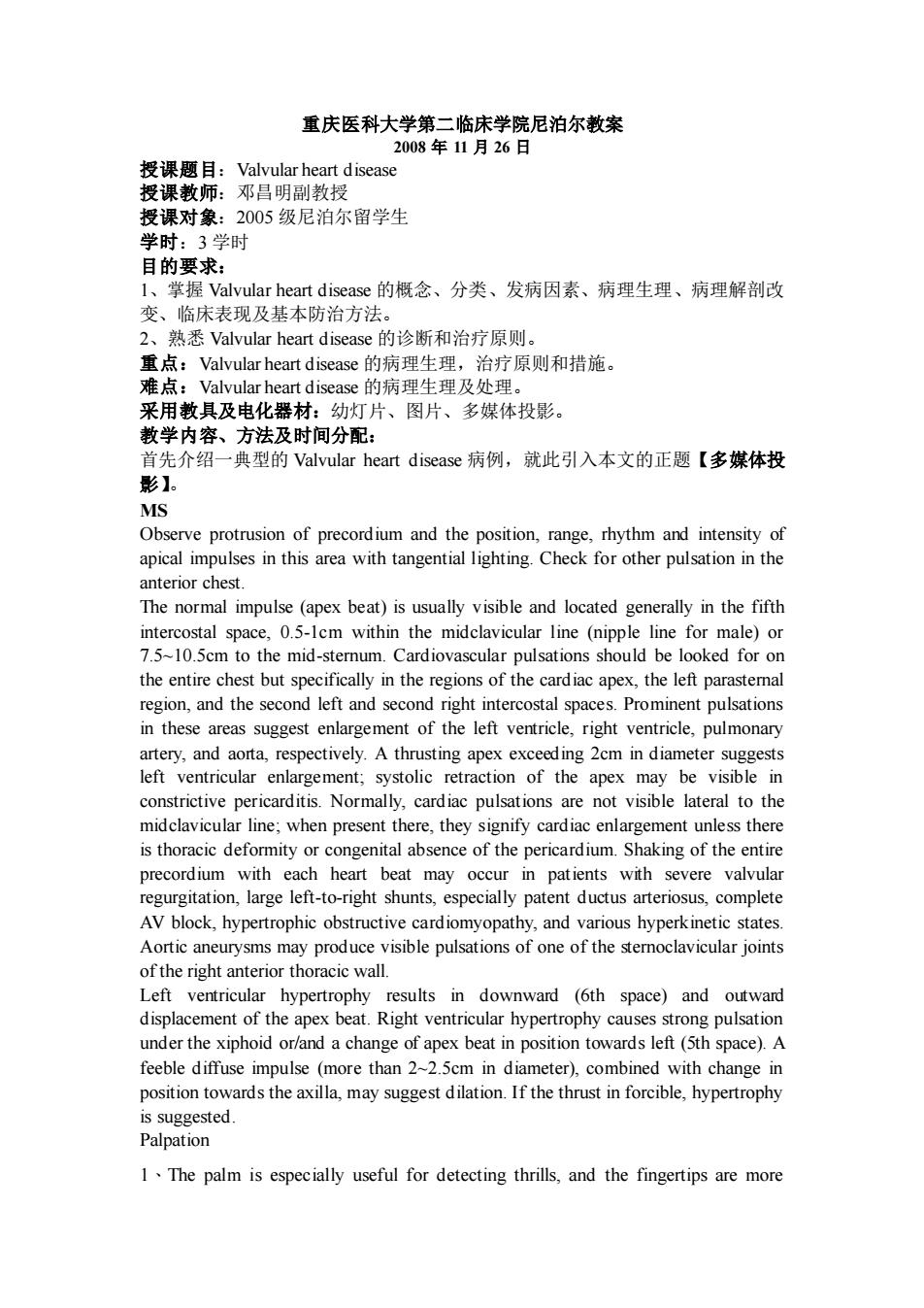
重庆医科大学第二临床学院尼泊尔教案 2008年11月26日 授课题目:Valvular heart disease 授课教师:邓昌明副教授 授课对象:2005级尼泊尔留学生 学时:3学时 目的要求: l、掌握Valvular heart disease的概念、分类、发病因素、病理生理、病理解剖改 变、临床表现及基本防治方法。 2、熟悉Valvular heart disease的诊断和治疗原则。 重点:Valvular heart disease的病理生理,治疗原则和措施 难点:Valvular heart disease的病理生理及处理。 采用教具及电化器材:幼灯片、图片、多媒体投影。 教学内容、方法及时间分配: 首先介绍一典型的Valvular heart disease病例,就此引入本文的正题【多媒体投 MS Observe protrusion of precordium and the position,range,rhythm and intensity of apical imp pulses in this area with tangential lighting.Check for other pulsation in the anterior The normal impulse(apex beat)is usually visible and located generally in the fifth intercostal space,0.5-Icm within the midclavicular line (nipple line for male)or 7.5~10.5cm to the mid-sternum.Cardiovascular pulsations should be looked for on the entire chest but specifically in the regions of the cardiac apex,the left parastemal region,and the second left and se ight inte s.Pr minent pulsations in these areas suggest enlargement of the left ventricle,right ventricle,pulmonary artery,and aorta,respectively.A thrusting apex exceeding 2cm in diameter suggests left ventricular enlargement;systolic retraction of the apex may be visible in constrictive pericarditis normally cardiac pulsations are not visible lateral to the midclavicular ine when present there they signify cardiac enlar ent unless there entir precordium with each heart beat may occur in patients with severe valvular regurgitation,large left-to-right shunts,especially patent ductus arteriosus,complete AV block,hypertrophic obstructive cardiomyopathy,and various hyperkinetic states. ay produce visible pulsations of one of the stemoclavicular joints Left ventricular hypertrophy results in downward (6th space)and outward displacement of the apex beat.Right ventricular hypertrophy causes strong pulsation under the xiphoid or/and a change of apex beat in position towards left(5th space).A feeble diffuse impulse (more than 2~2.5cm in diameter),combined with change in s suggested Palpation 1.The palm is especially useful for detecting thrills,and the fingertips are more
重庆医科大学第二临床学院尼泊尔教案 2008 年 11 月 26 日 授课题目:Valvular heart disease 授课教师:邓昌明副教授 授课对象:2005 级尼泊尔留学生 学时:3 学时 目的要求: 1、掌握 Valvular heart disease 的概念、分类、发病因素、病理生理、病理解剖改 变、临床表现及基本防治方法。 2、熟悉 Valvular heart disease 的诊断和治疗原则。 重点:Valvular heart disease 的病理生理,治疗原则和措施。 难点:Valvular heart disease 的病理生理及处理。 采用教具及电化器材:幼灯片、图片、多媒体投影。 教学内容、方法及时间分配: 首先介绍一典型的 Valvular heart disease 病例,就此引入本文的正题【多媒体投 影】。 MS Observe protrusion of precordium and the position, range, rhythm and intensity of apical impulses in this area with tangential lighting. Check for other pulsation in the anterior chest. The normal impulse (apex beat) is usually visible and located generally in the fifth intercostal space, 0.5-1cm within the midclavicular line (nipple line for male) or 7.5~10.5cm to the mid-sternum. Cardiovascular pulsations should be looked for on the entire chest but specifically in the regions of the cardiac apex, the left parasternal region, and the second left and second right intercostal spaces. Prominent pulsations in these areas suggest enlargement of the left ventricle, right ventricle, pulmonary artery, and aorta, respectively. A thrusting apex exceeding 2cm in diameter suggests left ventricular enlargement; systolic retraction of the apex may be visible in constrictive pericarditis. Normally, cardiac pulsations are not visible lateral to the midclavicular line; when present there, they signify cardiac enlargement unless there is thoracic deformity or congenital absence of the pericardium. Shaking of the entire precordium with each heart beat may occur in patients with severe valvular regurgitation, large left-to-right shunts, especially patent ductus arteriosus, complete AV block, hypertrophic obstructive cardiomyopathy, and various hyperkinetic states. Aortic aneurysms may produce visible pulsations of one of the sternoclavicular joints of the right anterior thoracic wall. Left ventricular hypertrophy results in downward (6th space) and outward displacement of the apex beat. Right ventricular hypertrophy causes strong pulsation under the xiphoid or/and a change of apex beat in position towards left (5th space). A feeble diffuse impulse (more than 2~2.5cm in diameter), combined with change in position towards the axilla, may suggest dilation. If the thrust in forcible, hypertrophy is suggested. Palpation 1、The palm is especially useful for detecting thrills, and the fingertips are more
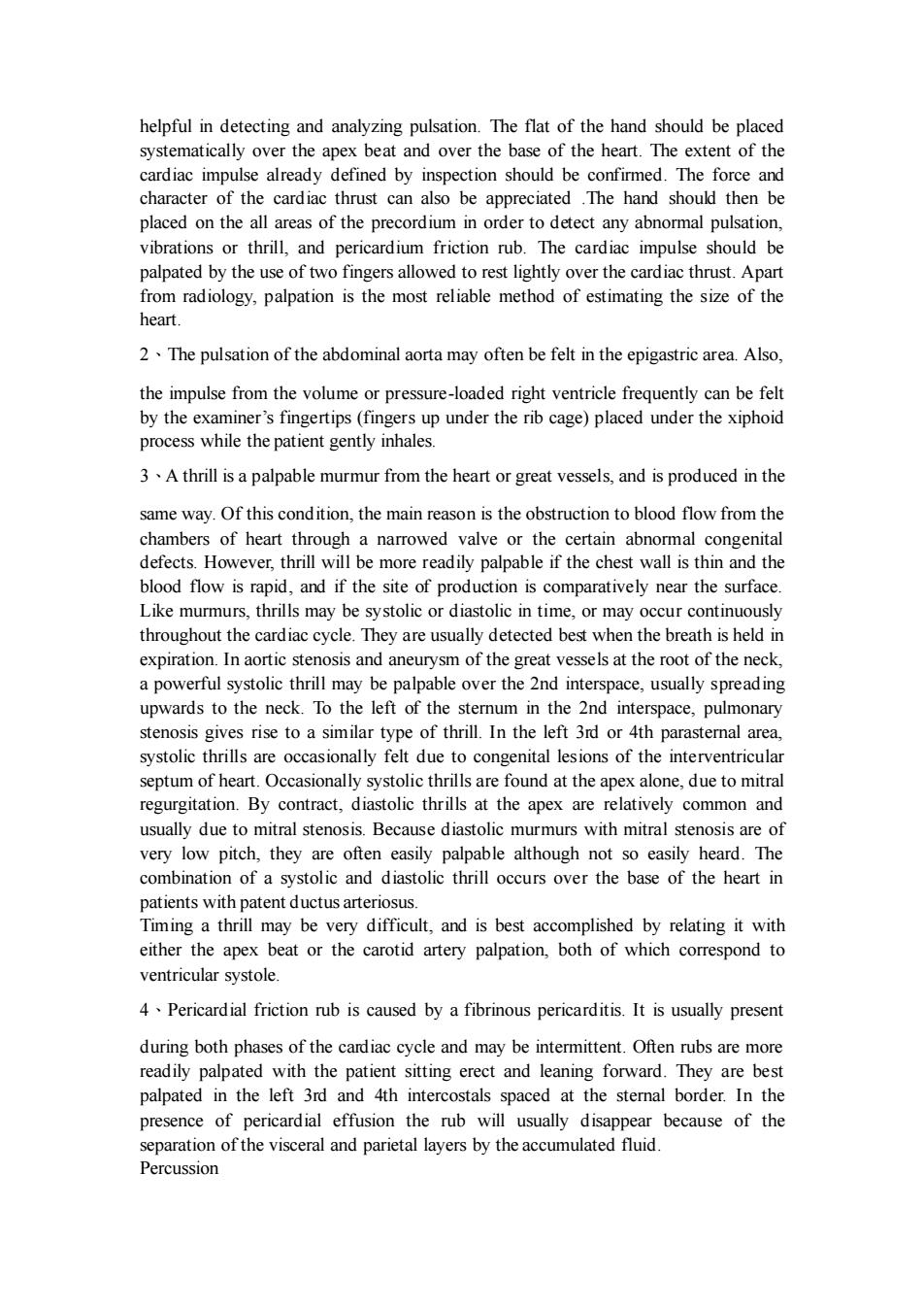
helpful in detecting and analyzing pulsation.The flat of the hand should be placed system ape y heat and over the of the heart.The extent of the cardiac impuls e already defined by inspection should be confired The force an character of the cardiac thrust can also be appreciated.The hand should then be placed on the all areas of the precordium in order to detect any abnormal pulsation, vibrations or thrill,and pericardium friction rub.The cardiac impulse should be palpated bytheuseof wo f allowe to res over the car rdiac thrust.Apart themost method of timating the of th heart 2The pulsation of the abdominal aorta may often be felt in the epigastric area.Also, the impulse from the voume or pressure-loaded right ventrice frequ ently can be felt by the exa r's fingertips(fingers up under the rib cage)placed under the xiphoid 3.A thrill is a palpable murmur from the heart or great vessels,and is produced in the same way.Of this condition.the main reason is the obstruction to blood flow from the of hea a narrowed v. the abn onge .However.thrill will be more readily palpable if the chest wall is thin and th blood flow is rapid,and if the site of production is comparatively near the surface. Like murmurs,thrills may be systolic or diastolic in time,or may occur continuously throughout the cardiac cycle.They are usually detected best when the breath is held in expiration.In aortic ste and ane sm of the great vessels at the root of the neck. a powerful systolic thrl may be palpa le over the 2nd interspace,usually spreading upwards to the neck.lo the left of the sternum in the 2nd interspace,pulmonary stenosis gives rise to a similar type of thrill.In the left 3rd or 4th parasternal area, systolic thrills are occasionally felt due to congenital lesions of the interventricular septum of heart.Occasionally systolic thrills are found at the apex alone.due to mitral contract.di astolic thrills at t the apex are latively comn and usually due to mitral stenosis.Because diastolic murmurs with mitral stenosis are of very low pitch.they are often easily palpable although not so easily heard.The combination of a systolic and diastolic thrill occurs over the base of the heart in patients with patent ductus arteriosus Timing a thrill may be very difficult,and is best accomplished by relating it with either the apex beat or the carotid artery palpation both of which to ventricular systole. 4 Pericardial friction rub is caused by a fibrinous pericarditis.It is usually present during both phases of the cardiac cycle and may be intermittent.Often rubs are more readily palpated with t and leanin forward.The e hes palpated in at the stmal presence of pericardial effusion the rub will usually disappear because of the separation of the visceral and parietal layers by the accumulated fluid. Percussion
helpful in detecting and analyzing pulsation. The flat of the hand should be placed systematically over the apex beat and over the base of the heart. The extent of the cardiac impulse already defined by inspection should be confirmed. The force and character of the cardiac thrust can also be appreciated .The hand should then be placed on the all areas of the precordium in order to detect any abnormal pulsation, vibrations or thrill, and pericardium friction rub. The cardiac impulse should be palpated by the use of two fingers allowed to rest lightly over the cardiac thrust. Apart from radiology, palpation is the most reliable method of estimating the size of the heart. 2、The pulsation of the abdominal aorta may often be felt in the epigastric area. Also, the impulse from the volume or pressure-loaded right ventricle frequently can be felt by the examiner’s fingertips (fingers up under the rib cage) placed under the xiphoid process while the patient gently inhales. 3、A thrill is a palpable murmur from the heart or great vessels, and is produced in the same way. Of this condition, the main reason is the obstruction to blood flow from the chambers of heart through a narrowed valve or the certain abnormal congenital defects. However, thrill will be more readily palpable if the chest wall is thin and the blood flow is rapid, and if the site of production is comparatively near the surface. Like murmurs, thrills may be systolic or diastolic in time, or may occur continuously throughout the cardiac cycle. They are usually detected best when the breath is held in expiration. In aortic stenosis and aneurysm of the great vessels at the root of the neck, a powerful systolic thrill may be palpable over the 2nd interspace, usually spreading upwards to the neck. To the left of the sternum in the 2nd interspace, pulmonary stenosis gives rise to a similar type of thrill. In the left 3rd or 4th parasternal area, systolic thrills are occasionally felt due to congenital lesions of the interventricular septum of heart. Occasionally systolic thrills are found at the apex alone, due to mitral regurgitation. By contract, diastolic thrills at the apex are relatively common and usually due to mitral stenosis. Because diastolic murmurs with mitral stenosis are of very low pitch, they are often easily palpable although not so easily heard. The combination of a systolic and diastolic thrill occurs over the base of the heart in patients with patent ductus arteriosus. Timing a thrill may be very difficult, and is best accomplished by relating it with either the apex beat or the carotid artery palpation, both of which correspond to ventricular systole. 4、Pericardial friction rub is caused by a fibrinous pericarditis. It is usually present during both phases of the cardiac cycle and may be intermittent. Often rubs are more readily palpated with the patient sitting erect and leaning forward. They are best palpated in the left 3rd and 4th intercostals spaced at the sternal border. In the presence of pericardial effusion the rub will usually disappear because of the separation of the visceral and parietal layers by the accumulated fluid. Percussion
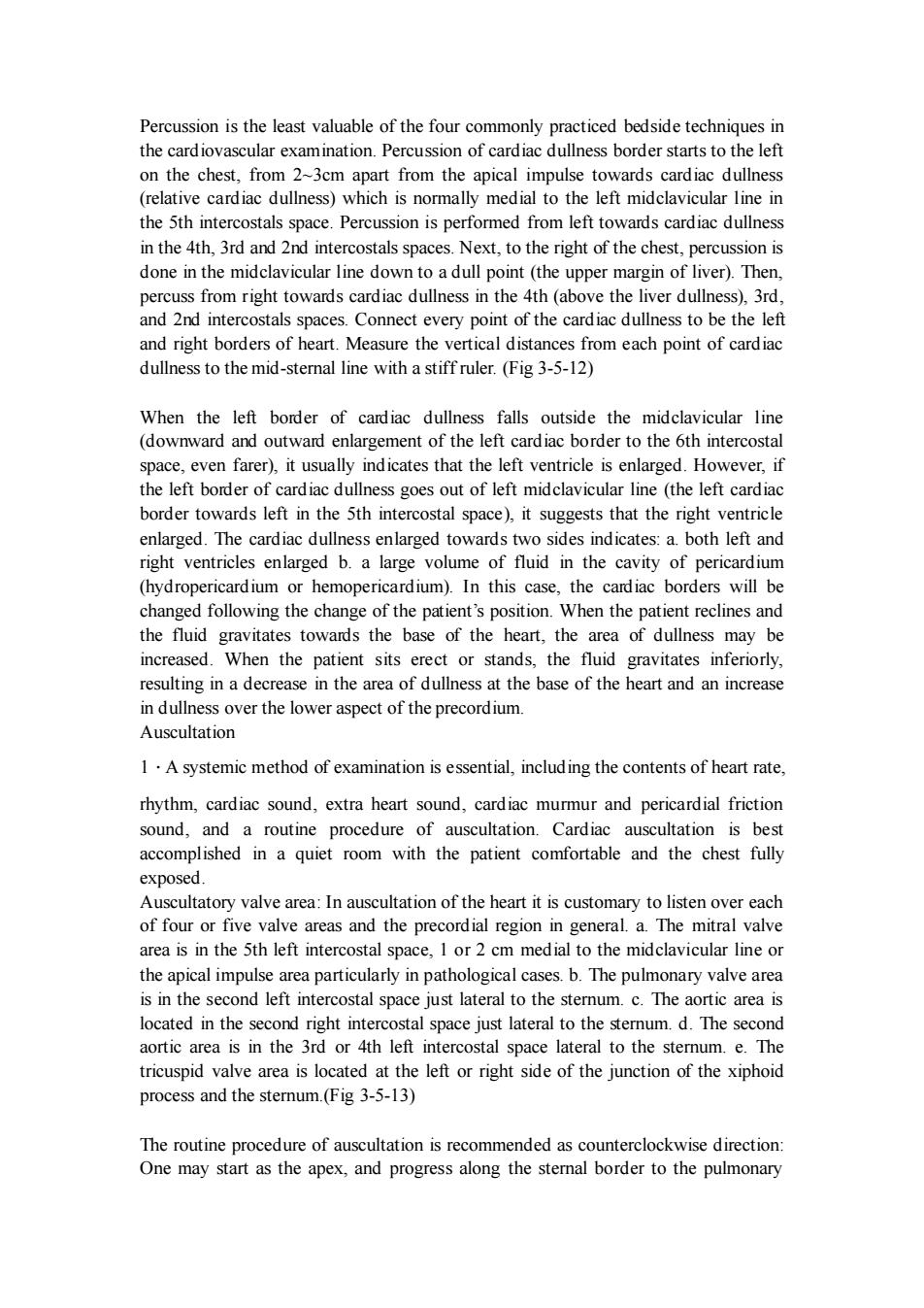
Perussion is the least valuable of the four commonly practiced bedside tc on the chest,from 2~3cm apart from the apical impulse towards cardiac dullness (relative cardiac dullness)which is normally medial to the left midclavicular line in the 5th intercostals space.Percussion is performed from left towards cardiac dullness in the 4th,3rd and 2nd intercostals spaces.Next.to the right of the chest.percussion is done in the midelavicular line downt a dull p (the upper margin of liver).The percuss from right towards cardiac dullness in the 4th (above the liver dullness),3rd and 2nd intercostals spaces.Connect every point of the cardiac dullness to be the left and right borders of heart.Measure the vertical distances from each point of cardiac dullness to the mid-sternal line with a stiff ruler.(Fig 3-5-12) When the left border of cardiac dullnes falls outside the midclavicular lin (downward and outward enlargement of the left card iac border to the 6th intercostal space,even farer),it usually indicates that the left ventricle is enlarged.However,if the left border of cardiac dullness goes out of left midclavicular line (the left cardiac border towards left in the 5th int rcostal space),it suggests that the right ventricle arged.The cardiac dullness larged toward sides indicat es:a.both left an right ventricles enlarged b.a large volume of fluid in the cavity of pericardiur (hydropericardium or hemopericardium).In this case.the cardiac borders will be changed following the change of the patient's position.When the patient reclines and the fluid gravitates towards the base of the heart,the area of dullness may be ed the patient sits ect or the flu d gravitates inferiorly resulting in a decrease in the area of dullness at the base of the heart and an increase in dullness over the lower aspect of the precordium. Auscultation 1.A systemic method of examination is essential.including the contents of heart rate rhythm,cardiac sound,extra heart sound,cardiac murur and pericardial friction sound,and a routine procedure of auscultation.Cardiac auscultation is best accomplished in a quiet room with the patient comfortable and the chest fully exnosed Auscultatory valve area:In auscultation of the heart it is customary to listen over each of four o d the precordial region gener mitral valve area is in the 5th left intercostal space.1or2 cm medial to the midclavicular line or the apical impulse area particularly in pathological cases.b.The pulmonary valve area is in the second left intercostal space just lateral to the sternum.c.The aortic area is located in the second right intercostal space just lateral to the stemum.d.The second aortic rea is in the 3rd or 4th left in ostal s e lateral to the The tricuspi e area is located at the left or right side of the junction of the xiphoid process and the sternum.(Fig 3-5-13) The routine procedure of auscultation is recommended as counterclockwise direction One may start as the apex,and progress along the stemal border to the pulmonary
Percussion is the least valuable of the four commonly practiced bedside techniques in the cardiovascular examination. Percussion of cardiac dullness border starts to the left on the chest, from 2~3cm apart from the apical impulse towards cardiac dullness (relative cardiac dullness) which is normally medial to the left midclavicular line in the 5th intercostals space. Percussion is performed from left towards cardiac dullness in the 4th, 3rd and 2nd intercostals spaces. Next, to the right of the chest, percussion is done in the midclavicular line down to a dull point (the upper margin of liver). Then, percuss from right towards cardiac dullness in the 4th (above the liver dullness), 3rd, and 2nd intercostals spaces. Connect every point of the cardiac dullness to be the left and right borders of heart. Measure the vertical distances from each point of cardiac dullness to the mid-sternal line with a stiff ruler. (Fig 3-5-12) When the left border of cardiac dullness falls outside the midclavicular line (downward and outward enlargement of the left cardiac border to the 6th intercostal space, even farer), it usually indicates that the left ventricle is enlarged. However, if the left border of cardiac dullness goes out of left midclavicular line (the left cardiac border towards left in the 5th intercostal space), it suggests that the right ventricle enlarged. The cardiac dullness enlarged towards two sides indicates: a. both left and right ventricles enlarged b. a large volume of fluid in the cavity of pericardium (hydropericardium or hemopericardium). In this case, the cardiac borders will be changed following the change of the patient’s position. When the patient reclines and the fluid gravitates towards the base of the heart, the area of dullness may be increased. When the patient sits erect or stands, the fluid gravitates inferiorly, resulting in a decrease in the area of dullness at the base of the heart and an increase in dullness over the lower aspect of the precordium. Auscultation 1.A systemic method of examination is essential, including the contents of heart rate, rhythm, cardiac sound, extra heart sound, cardiac murmur and pericardial friction sound, and a routine procedure of auscultation. Cardiac auscultation is best accomplished in a quiet room with the patient comfortable and the chest fully exposed. Auscultatory valve area: In auscultation of the heart it is customary to listen over each of four or five valve areas and the precordial region in general. a. The mitral valve area is in the 5th left intercostal space, 1 or 2 cm medial to the midclavicular line or the apical impulse area particularly in pathological cases. b. The pulmonary valve area is in the second left intercostal space just lateral to the sternum. c. The aortic area is located in the second right intercostal space just lateral to the sternum. d. The second aortic area is in the 3rd or 4th left intercostal space lateral to the sternum. e. The tricuspid valve area is located at the left or right side of the junction of the xiphoid process and the sternum.(Fig 3-5-13) The routine procedure of auscultation is recommended as counterclockwise direction: One may start as the apex, and progress along the sternal border to the pulmonary
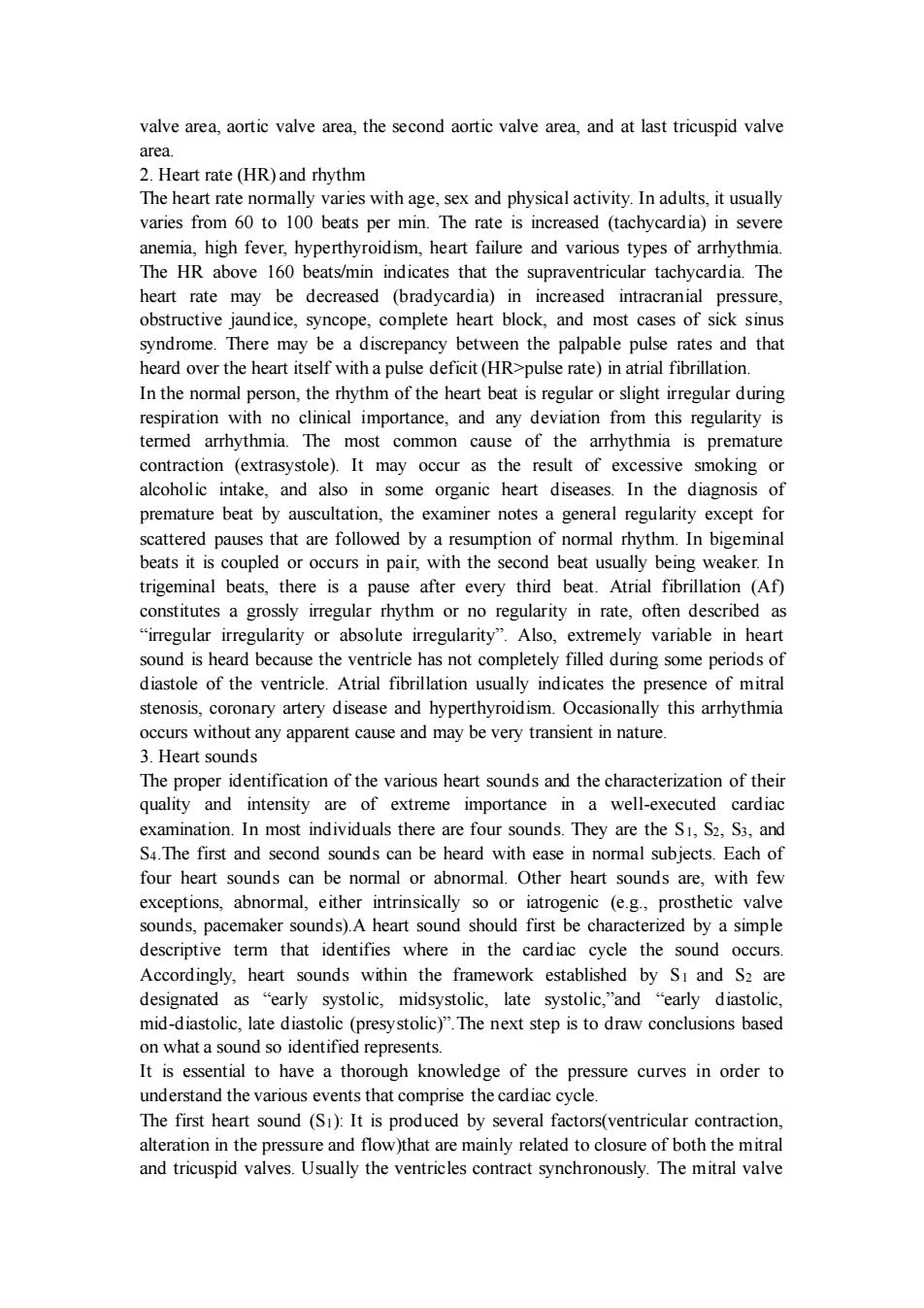
valve area,aortic valve area,the second aortic valve area,and at last tricuspid valve The heart rate normally varies with age.sex and physical activity.In adults.it usually varies from 60 to 100 beats per min.The rate is increased (tachycardia)in severe anema,high fever,hyperthyroidism,heart failure and various types of arrhythma The HR above 160 beats/n e supraven tachycardia.The rate may be decreased dia) intracran pressure obstructive jaundice,syncope,complete heart block,and most cases of sick sinus syndrome.There may be a discrepancy between the palpable pulse rates and that heard over the heart itself with a pulse deficit(HR>pulse rate)in atrial fibrillation. In the nomaLperson the rhvthm of the heant beat is regular or slight irregular during nical and any devi ation from this regularity is arrhythmia. The most common cause of the arrhythmia is premature contraction (extrasystole).It may occur as the result of excessive smoking or alcoholic intake,and also in some organic heart diseases.In the diagnosis of premature beat by auscultation,the examiner notes a general regularity except for tha are followed by a ormal In b sem or occurs in pair,with the secc beat usually ng weaker trigeminal beats.there is a pause after every third beat.Atrial fibrillation (Af) constitutes a grossly irregular rhythm or no regularity in rate,often described as irregular irregularity or absolute irregularity".Also.extremely variable in heart sound is heard becau use the ventricle has not diastole of the ventrice Atrial fibrillation usual completely filled during sm periods of cates the prese nce of mitral stenosis,coronary artery disease and hyperthyroidism.Occasionally this arrhythmia occurs without any apparent cause and may be very transient in nature 3 Heart sounds The proper identification of the various heart sounds and the characterization of their nd ance in uted cardiac examination.In most individuals there are four sounds.They are the S S2,S3,an S4.The first and second sounds can be heard with ease in normal subjects.Each of four heart sounds can be normal or abnormal.Other heart sounds are,with few exceptions,abnormal,either intrinsically so or iatrogenic (e.g., prosthetic valve sounds,pacemaker sounds).A heart sound should first be ized by a simple descriptive tem that identifie where in the cardiac the sound occur Accordingly,heart sounds within the framework established by Si and S2 are designated as "early systolic,midsystolic,late systolic,"and "early diastolic, mid-diastolic,late diastolic (presystolic)".The next step is to draw conclusions based on what a sound so identified r It is ess ntial to have a th ough knowledge of the pressure curves in order to understand the various events that comprise the cardiac cycle. The first heart sound (S1):It is produced by several factors(ventricular contraction. alteration in the pressure and flow)that are mainly related to closure of both the mitral and tricuspid valves.Usually the ventricles contract synchronously.The mitral valve
valve area, aortic valve area, the second aortic valve area, and at last tricuspid valve area. 2. Heart rate (HR) and rhythm The heart rate normally varies with age, sex and physical activity. In adults, it usually varies from 60 to 100 beats per min. The rate is increased (tachycardia) in severe anemia, high fever, hyperthyroidism, heart failure and various types of arrhythmia. The HR above 160 beats/min indicates that the supraventricular tachycardia. The heart rate may be decreased (bradycardia) in increased intracranial pressure, obstructive jaundice, syncope, complete heart block, and most cases of sick sinus syndrome. There may be a discrepancy between the palpable pulse rates and that heard over the heart itself with a pulse deficit (HR>pulse rate) in atrial fibrillation. In the normal person, the rhythm of the heart beat is regular or slight irregular during respiration with no clinical importance, and any deviation from this regularity is termed arrhythmia. The most common cause of the arrhythmia is premature contraction (extrasystole). It may occur as the result of excessive smoking or alcoholic intake, and also in some organic heart diseases. In the diagnosis of premature beat by auscultation, the examiner notes a general regularity except for scattered pauses that are followed by a resumption of normal rhythm. In bigeminal beats it is coupled or occurs in pair, with the second beat usually being weaker. In trigeminal beats, there is a pause after every third beat. Atrial fibrillation (Af) constitutes a grossly irregular rhythm or no regularity in rate, often described as “irregular irregularity or absolute irregularity”. Also, extremely variable in heart sound is heard because the ventricle has not completely filled during some periods of diastole of the ventricle. Atrial fibrillation usually indicates the presence of mitral stenosis, coronary artery disease and hyperthyroidism. Occasionally this arrhythmia occurs without any apparent cause and may be very transient in nature. 3. Heart sounds The proper identification of the various heart sounds and the characterization of their quality and intensity are of extreme importance in a well-executed cardiac examination. In most individuals there are four sounds. They are the S1, S2, S3, and S4.The first and second sounds can be heard with ease in normal subjects. Each of four heart sounds can be normal or abnormal. Other heart sounds are, with few exceptions, abnormal, either intrinsically so or iatrogenic (e.g., prosthetic valve sounds, pacemaker sounds).A heart sound should first be characterized by a simple descriptive term that identifies where in the cardiac cycle the sound occurs. Accordingly, heart sounds within the framework established by S1 and S2 are designated as “early systolic, midsystolic, late systolic,”and “early diastolic, mid-diastolic, late diastolic (presystolic)”.The next step is to draw conclusions based on what a sound so identified represents. It is essential to have a thorough knowledge of the pressure curves in order to understand the various events that comprise the cardiac cycle. The first heart sound (S1): It is produced by several factors(ventricular contraction, alteration in the pressure and flow)that are mainly related to closure of both the mitral and tricuspid valves. Usually the ventricles contract synchronously. The mitral valve
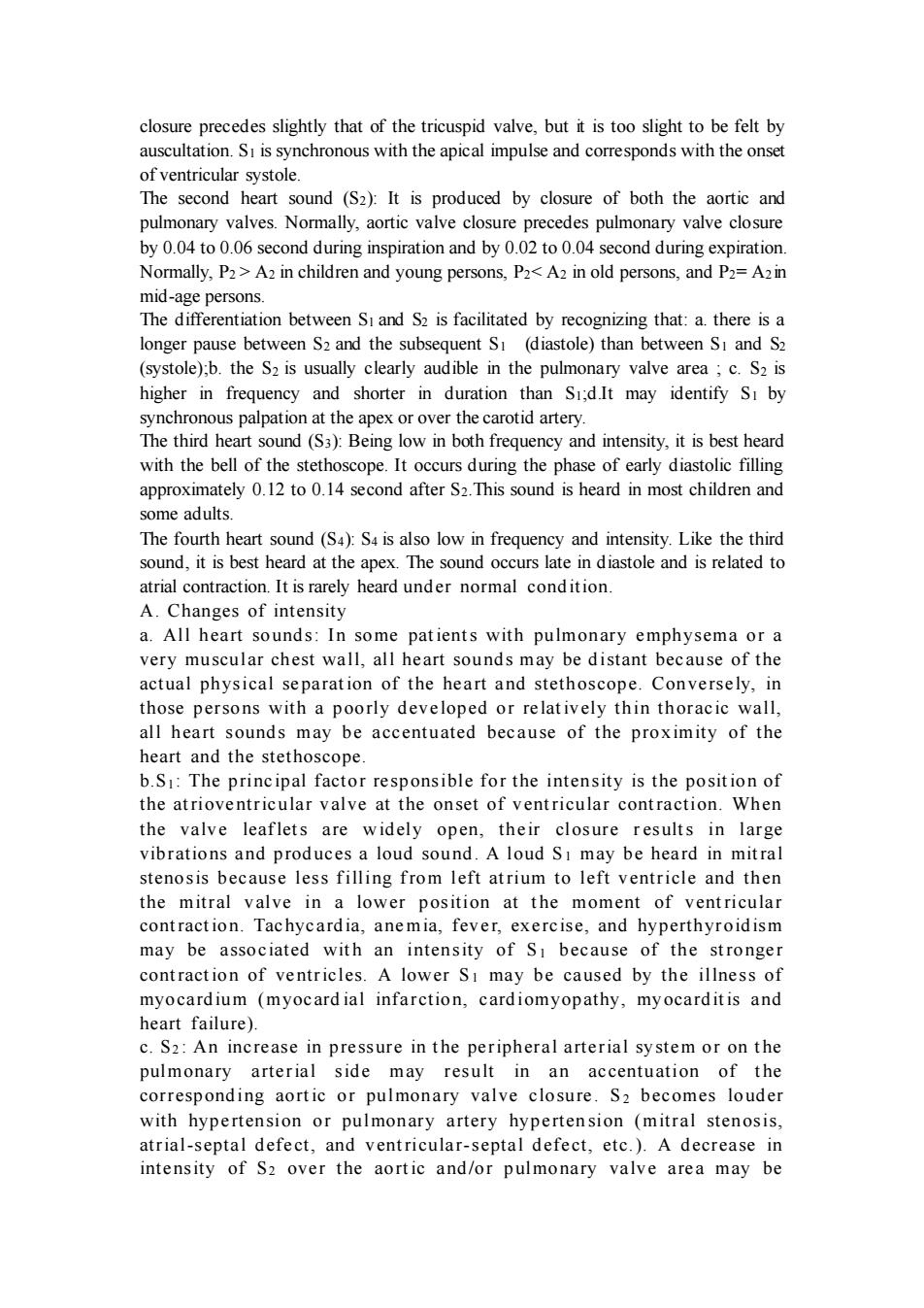
closure of ventricular systole. The second heart sound (S2):It is produced by closure of both the aortic and pulmonary valves.Normally,aortic valve closure precedes pulmonary valve closure by 0.04 to 0.06 second during inspiration and by 0.02 to0.04 second during expiration Normally,P2>A2 in children and young persons,P2<A2 in old persons,and P2=A2 mid-age persons The differentiation between SI and S2 is facilitated by recognizing that:a.there is a longer pause between S2 and the subsequent S(diastole)than between S and S2 (systole):b.the s,is usually clearly audible in the pulmonary valve area:c.S,is higher in freque and shorter in duration than Si:d.It may identify St by synchronous palpation at the apex or over the carotid artery. The third heart sound (S3):Being low in both frequency and intensity.it is best heard with the bell of the stethoscope.It occurs during the phase of early diastolic filling tely 0.12 to 0.14 second after S2.This sound is heard in most c me adults The fou ear tsound (S4):S4 is also low in frequency y and inte sity.Like the third sound,it is best heard at the apex.The sound occurs late in diastole and is related to atrial contraction.It is rarely heard under normal condition. A.Changes of intensity a all heart sounds:In some patients with pulmonary emphysema or a very muscu chest wall,all he ar sounds may be distant because of the actual physical separation of the heart and stethoscope Conversely,i those persons with a poorly developed or relatively thin thoracic wall, all heart sounds may be accentuated because of the proximity of the heart and the stethoscope b.S:The principal fac position of the atri nsible for the intensity is the p lar valve at he onset of ventricular contraction.Wher the valve leaflets are widely open,their closure results in large vibrations and produces a loud sound.A loud Si may be heard in mitral stenosis because less filling from left atrium to left ventricle and then the mitral valve in a lower position at the moment of ventricular contraction.Ta chy anemia ise,an d hy perthyroidism may be associated with an intensity of Si because of the stronge contraction of ventricles.A lower SI may be caused by the illness of myocardium (myocardial infarction.cardiomyopathy,myocarditis and heart failure) c.S2:An inc rease in pr ressure in the pe eripheral arterial system or on the pulmonary arterial side may result in an accentuation of the corresponding aortic or pulmonary valve closure.S2 becomes louder with hypertension or pulmonary artery hypertension (mitral stenosis, atrial-septal defect,and ventricular-septal defect,etc.).A decrease in intensity of S2 over the aortic and/or pulmonary valve area may be
closure precedes slightly that of the tricuspid valve, but it is too slight to be felt by auscultation. S1 is synchronous with the apical impulse and corresponds with the onset of ventricular systole. The second heart sound (S2): It is produced by closure of both the aortic and pulmonary valves. Normally, aortic valve closure precedes pulmonary valve closure by 0.04 to 0.06 second during inspiration and by 0.02 to 0.04 second during expiration. Normally, P2 > A2 in children and young persons, P2< A2 in old persons, and P2= A2 in mid-age persons. The differentiation between S1 and S2 is facilitated by recognizing that: a. there is a longer pause between S2 and the subsequent S1 (diastole) than between S1 and S2 (systole);b. the S2 is usually clearly audible in the pulmonary valve area ; c. S2 is higher in frequency and shorter in duration than S1;d.It may identify S1 by synchronous palpation at the apex or over the carotid artery. The third heart sound (S3): Being low in both frequency and intensity, it is best heard with the bell of the stethoscope. It occurs during the phase of early diastolic filling approximately 0.12 to 0.14 second after S2.This sound is heard in most children and some adults. The fourth heart sound (S4): S4 is also low in frequency and intensity. Like the third sound, it is best heard at the apex. The sound occurs late in diastole and is related to atrial contraction. It is rarely heard under normal condition. A. Changes of intensity a. All heart sounds: In some pat ient s with pulmonary emphysema or a very muscular chest wall, all heart sounds may be distant because of the actual physical separat ion of the heart and stethoscope. Conversely, in those persons with a poorly developed or relat ively thin thoracic wall, all heart sounds may be accentuated because of the proximity of the heart and the stethoscope. b.S1 : The principal factor responsible for the intensity is the posit ion of the at rioventricular valve at the onset of vent ricular cont raction. When the valve leaf let s are w idely open, their closure r esult s in large vibrations and produces a loud sound. A loud S1 may be heard in mit ral stenosis because less f illing f rom left at rium to left ventricle and then the mitral valve in a low er position at t he moment of vent ricular cont ract ion. Tachycardia, ane mia, fever, exercise, and hyperthyroidism may be associated wit h an intensity of S1 because of the st ronger cont ract ion of ventricles. A low er S1 may be caused by the illness of myocardium (myocard ial infarction, cardiomyopathy, myocardit is and heart failure). c. S2 : An increase in pressure in t he peripheral arterial system or on t he pulmonary arterial side may result in an accentuation of t he corresponding aort ic or pulmonary valve closure. S 2 becomes louder with hypertension or pulmonary artery hyperten sion (mitral stenosis, atrial-septal defect, and vent ricular-septal defect, etc.). A decrease in intensity of S2 over the aort ic and/or pulmonary valve area may be